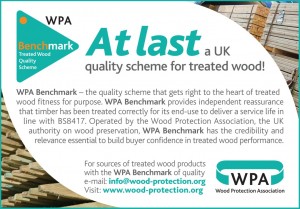All landscapers know about treated wood. It’s green; its protected against wood decay and insects. This is true. However, whilst wood may look treated, how sure can you be that it will be fit for the use intended? There is a way of making sure. British Standards require that treated wood is given a level of protection that matches its end use. For example, an outdoor deck, fence or pergola post should contain higher levels of preservative than components that are out of ground contact like pergola rails and deck boards. BS8417 is the British Standard for treated wood which groups timber applications into four “use classes”. If treated wood to deliver the performance you require – 15, 30 or 60 years, follow the “golden rules” in our buyers guide below:
Treated wood buyers guide
- Always identify the Use Class before ordering.
- Specify that treatment must be in accordance with BS8417 for this Use Class
- Specify the desired service life – 15, 30 and 60 years are the options in BS8417
- Ask your supplier to verify, in writing, that your wood has been treated to the specification you require i.e. on the delivery note and invoice or as a separate treatment certificate.
- When buying treated wood from stock always get the supplier to verify, in writing which Use Class it is suitable for.
- Never substitute wood treated for an indoor Use Class for an external Use Class – failure is inevitable.
- Use Class 4 is the level of treatment required for components in direct ground contact. Anything less and service life, structural safety and customer satisfaction will be compromised.
- If third-party reassurance of fitness for purpose is required ask for components certificated under the WPA Benchmark quality assurance scheme.
- Always buy a can of end grain sealer compatible with the treatment preservative for re-treating wood that is cross cut, knotched or bored during installation.
| Treated wood Use Class categories source:BS8417:2011 | |
| Use Class 1 | Internal timbers – low risk of wetting
Floor joists and glulam beams |
| Use Class 2 | Internal timbers – intermittent risk of wetting
Roofing timbers |
| Use Class 3A
|
Outdoor wood above ground – coated
Window frames, doors, external cladding |
| Use Class 3B | Outdoor wood above ground – uncoated
Deck boards and joists, balustrades and fence rails |
| Use Class 4 | Outdoor wood in ground and freshwater contact
Fence posts, deck posts and joists, sleepers, pergola posts, bridge and board walk support, earth retaing walls. |
Want more detailed information
For more detailed specification guidance about treatment and the different types of preservatives available the Wood Protection Association (WPA) publishes a Manual of Industrial wood preservation –specification & practice.
e-mail info@wood-protection.org for details.
The Manual of Wood Preservation is the essential guide to specifiying and using treated wood correctly for its end use.
About the WPA
The Wood Protection Association (WPA) is a not for profit technical and advisory body interested in the development and promotion of timber protection technology to support the use of wood as a cost effective, sustainable construction material. The WPA operates the Benchmark quality scheme for treated wood which provides third party verification that a treated product will perform in line with British Standard desired service life requirements.




